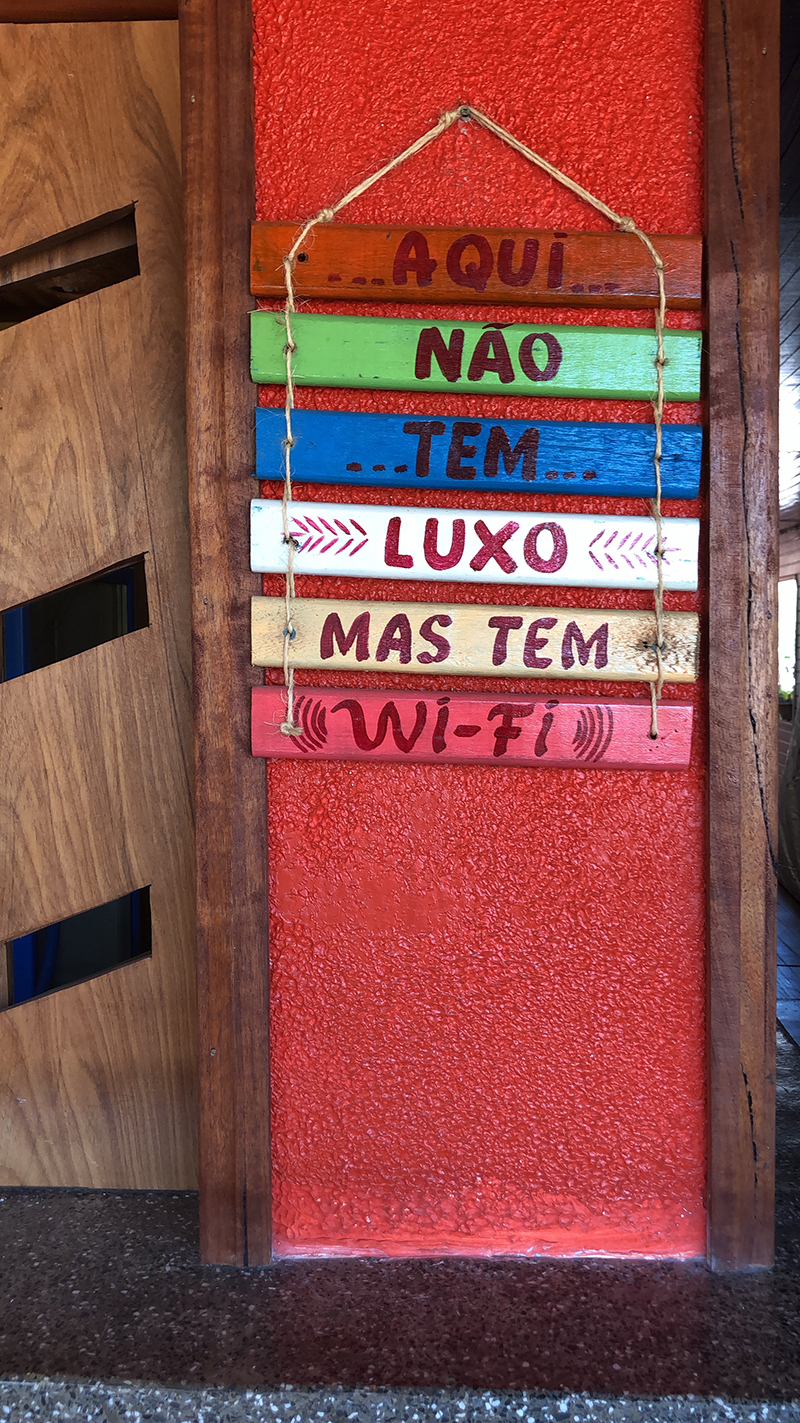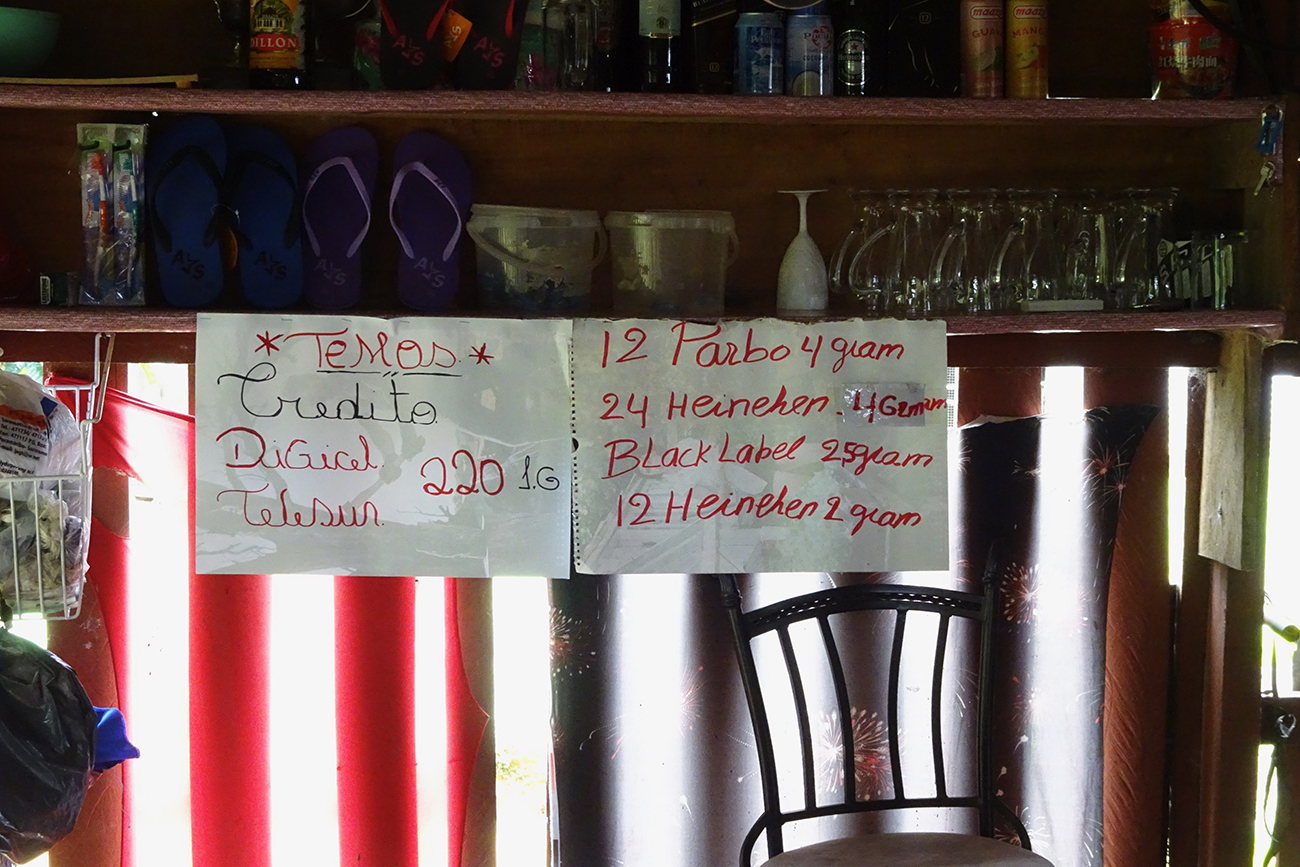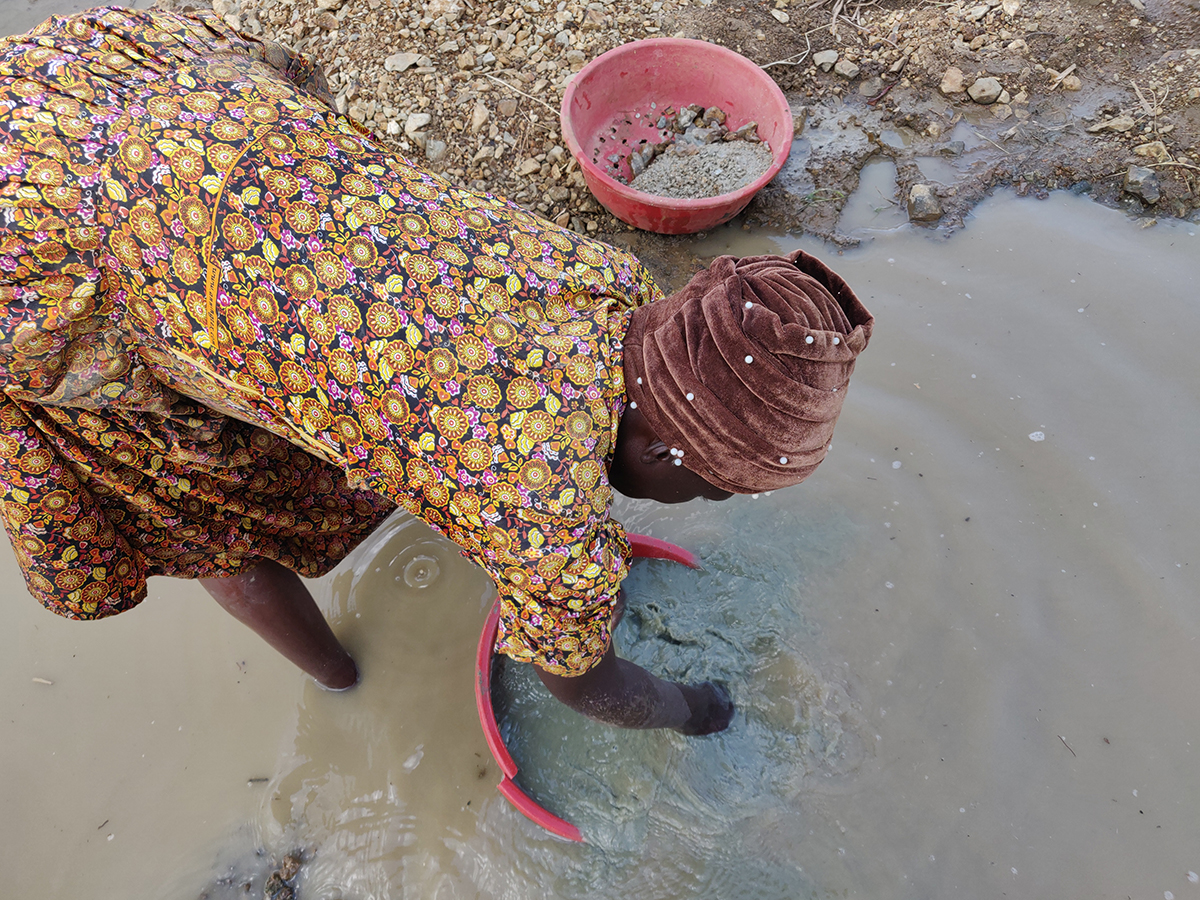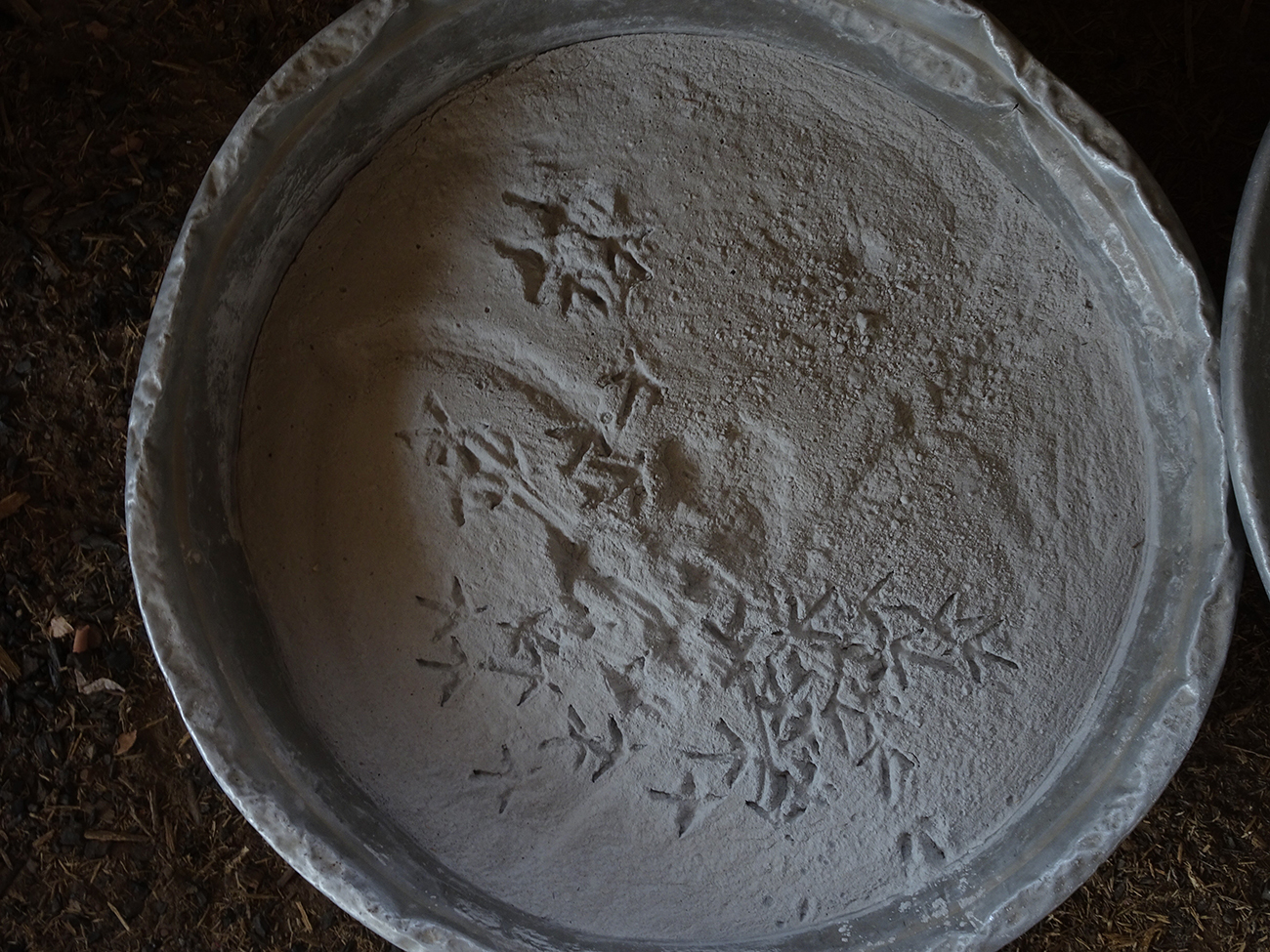Gold Lifeways
Gold has a lifeline that traces its transformation, dug from the ground, from rivers and wetlands, extracted and processed to materialize as ‘pure’ gold. Experts excavate, process, and trade gold – miners skilled at finding gold, at mastering new techniques, at negotiating work. Gold itself may be seen as a living entity that requires care, rest and the right forms of appropriation, as it binds itself to miners’ lives and cosmologies. Gold makes its mark, in footprints, on nuggets worn ostentatiously by miners, or hidden in pockets. It appears in graffiti, on street names, hotels, cinemas, and the ubiquitous statues of miners marking territory in the Amazon. Stimulated by gold, people grow as collectives, building miners’ associations and co-operatives within Gold Lifeways. Lifeways change, they are not fixed or linear; miners travel and bring with them new technology, ideas or skills; cooperatives stimulate transformation. The line is not finite; new chemicals, machinery and techniques extend possibilities of extraction; waste becomes a resource for others; old sites are revisited; an air pump doubling as a telephone. Markets shape the booms and busts of gold prices, and the material wealth that flows from the gold. Officials too, permitting, restraining, and controlling miners’ options. Repeatedly, in different places, accessing land, and the relations of land tenure are vital – for male miners, women miners, and local inhabitants. Mining infrastructures extend into the subterranean and across land, creating cohabitations, building conviviality, stimulating conflict.
Amazon
In the Amazon, gold mining dictates a lifestyle that influences the development of local communities. It is alive in the names of hotels, streets, equipment stores, general shops, and a historical movie theatre. Words like “ouro”, “gold”, “garimpo” and “garimpeiro” are omnipresent in the streetscape. Depending on the distance from the closest villages, miners usually live in the vicinity of the mining site. The living quarters can be more or less structured, but there is always a hammock to ensure some comfortable rest. Closer to urban places sometimes wifi is available. In other cases, people have to walk to the nearest hill to be able to connect to telephone and internet lines to maintain long-distance relationship with families. In Brazil, cooperatives disseminate messages about the transformation of the image of garimpeiros. They promote miners as a social group concerned with sustainability issues, reducing mercury pollution, legalizing mining operations, and generating technological innovation for cleaner extraction.
Uganda
Gold lifeways are characterised by precarity, expectations, waiting, and sometimes by (often temporary) security. Miners build lives for themselves from gold, when fortunate. Land issues can be critical, as can the economic factors needed to make a living and invest in mining. This is gendered; women are rarely landowners, which constrains their access to mineral rich land and to credit. For women, mining is also combined with other livelihood demands and with their caring roles. Organisational dynamics feed into transformations within gold lifeways. In Busia, NGOs such as EWAD support miners to establish and consolidate Artisanal and Small-scale Miners’ Organisations (ASMOs). ASMOs act as vehicles for sustainability changes, consolidating small-scale mining operations, eliminating child labour, improving the position of women, introducing cleaner technologies, and accessing different markets.
West Africa
Gold has a life-line in which gold matter is extracted and then processed at the end of which it materializes as ‘pure’ gold. Along these steps, gold matter is transformed in the hands of many experts mastering specific technologies. This series follows first of all these Gold Lifeways. The line is not linear and finite; new technologies extend possibilities of extracting gold from ore and leftovers (tailings), and old sites can be revisited for new extraction. Gold Lifeways also refers to the lives and lifestyles of people involved in these mining activities. Lifeways that are expressed in work ethos, expertise, leisure, clothing styles, perspectives on life and ambitions for the future.
Amazon
1/4 Hotel dos garimpeiros
This hotel is located in the main street of Creporizão. The majority of garimpeiros migrate from region to region to work in different mines. Most mines are a far away, sometimes only reachable by plane, so when miners reach the village, they stay in hotels like this.
2/4 Hardware store on the Transgarimpeira road
“A casa do garimpeiro” offers every kind of material, tool and equipment for garimpeiros. Since the road was built, more specialized tools and equipment could reach these remote regions.
3/4 Rua dos garimpeiros
This is one of the main streets in the village. Peixoto has a stable community where everyone is directly or indirectly involved in the garimpo activity.
4/4 “Cine Ouro”
The “Gold” Movie Theater. This photo from the 1980s is part of the collection of the Museum of Itaituba. It shows how much the garimpo is part of the local history of the village and gold is present in many aspects of daily life; it is not just work life.




1/6 Miners’ camp
When a new mine is being developed, a place for miners and their families to live also has to be built. As the miners move frequently, they are very adept at building new barracks. Plastic sheeting and locally harvested wood are the main materials used.
2/6 Living quarters
The living quarters of the miners can be more or less structured, but there is always a hammock.
3/6 Kitchen in the mine camp
4/6 Child takes a bath in the mine camp
5/6 Family live in the mines
6/6 Broken freezer






1/2 Mobility is the basis for success
Gold seekers are always ready to leave for richer gold fields, better opportunities, or to take riches home. A hammock and a few bags are all that is needed. On the billboard of the gold buying company Ourominas, it says in Portuguese and in Surinamese (Sranantongo) "You can trust me."
2/2 After the gold rush
This is a remnant of a miners' shelter after they moved on.


1/3 “Aqui não tem luxo, mas tem wi-fi”
“Here we don’t have any luxury, but we have wifi.” This phrase is written at the entrance of a hotel located in Creporizão. This hotel hosts garimpeiros, gold buyers, and researchers.
2/3 Drinking for gold
In this bar, gold is currency. Telephone credits and alcoholic drinks are priced in grams of gold. The bar was recently built close to the mines where most gold is now found. At weekends, there are parties, sometimes bingo nights with live music, and many miners come here to relax.



1/4 Gold mining and the law
“When the law ignores reality, reality takes revenge by ignoring the law”, a message on a wall in Novo Progresso. Messages like this, both on walls and in conversations, are emblematic of the ever-transforming conflicts between garimpeiros and the law-enforcement state agents in the Brazilian Amazon.
2/4 “Transforming our image”
A newspaper clipping from the COOGAMIBRA (Cooperative of garimpeiros and miners of Brazil) stuck to a wall. It says: “Castelo dos Sonhos: transforming the image of our garimpos”. Cooperatives and associations form a network for information exchange and the mobility of ideas, experiences, and technology.
3/4 Legalization and transformation
A poster by COOPERTRANS (Cooperative of garimpeiros from Morais Almeida and Transgarimpeira road) inviting garimpeiros to join the cooperative. “Legalização e transformação” is their slogan. A cooperative goal is to ensure transformation of the sector and of the image of garimpeiros.
4/4 Model of a modern gold mine
The model that represents a modern gold mine was exposed during the "Dia do garimpeiro", a feast that celebrates the miner's profession, in the municipality of Peixoto de Azevedo. The initiative is part of the efforts of the local cooperative to reinforce good practices in the activity.




Uganda
1/2 Overseeing all the activities
This is a special tree - an itiiri tree. Three male leaders and landowners of Busia United Small-scale Mining Company (BUSCO) sit here to oversee and organise their mine. It is part of mining: being there when something requires attention. The village Tiira is named after this tree; itiira means ‘hand thorns’ in Ateso.
2/2 “We do not own the land”
Women usually do not own land, men do. Angariama Mining Association (AMA) consists mostly of women. In the photo, AMA members assess the progress of the mine. It is slow. Their struggle is not about attitude, but about land ownership. Land generally facilitates a loan with the bank.


1/3 Miners’ organise - BUSCO
Busia United Small-scale Mining Company started small in 1998, becoming the first registered association in Busia in 2010.
2/3 Miners’ organise – SAMA
In 2016, Syanyonja Artisanal Miners’ Association became the first association in Africa awarded certification by FLO-CERT to trade ‘Fairtrade gold’.
3/3 Miners’ organise - TLAMA
Tiira Landlords and Artisanal Miners Association is a miner – landowner collaboration.



1/2 “We have no case with anyone!”
Miners of Tiira Small Scale Mining Association (TISSMA) can resume mining activities after a 2-year stand-still due to a dispute with a foreign investor. They celebrate and are proud to have won the court case: “today we are free.”
2/2 Children should work on dreams
Young people from Buteba and Sikuda Gold Mining Communities who are part of a project led by EWAD to establish child labour free zones. School dropouts have been enabled to return and youth have built an economically successful soap making enterprise.


1/3 Mine reclamation
The lives of mines are not unilineal. They can remain open after the mining activities - to be repurposed later through new technologies. Or it can be closed. This photo displays a mine reclamation. When miners of Busia United Small-scale Mining Company (BUSCO) discontinued their activities here, they planted trees on the mining location.
2/3 In my backyard
Here, people mine right next to their house. This is not unusual - although usually such mines are smaller. In this village, mining is part of the residential area.
3/3 “We dig up the school fees”
This mine is not active, but still it remains open. The family living here depends on food from their garden. Sometimes, though, in case it is necessary, they dig up school fees.



1/4 Digging for crops and gold
These women are on their way to their garden to dig. In the morning, before breakfast, they go to harvest their crops. In the afternoon, after cooking their children’s lunch, they return to dig for gold.
2/4 Family land
A woman oversees her family land.
3/4 Wetland, women and mining
Women go to the wetland to mine alluvial gold. Men do too, but the wetland is a place where women can be miners themselves and organise their daily mining life, outside the gender division of labour and structures that apply to the established mines.
4/4 A precise technology
This miner is mining in the wetland and washes mud with a basin in search for alluvial gold. This technology requires careful attention and movement in order to find the gold.




West Africa
Trace of chicken feet in Powder Money
Gold mining and processing ore takes place in the middle of communities of farmers who keep animals: goats, chicken, and cattle. Here the pathways of mining and agricultural livelihoods cross in telling ways. What does the photograph portray - which choices can community members make, which (alternative) futures can be traced?

Forging tools for the miners
Blacksmiths are called numu in Malinké, and constitute a caste or hereditary profession in many Mande societies. Here, a local forge fabricating and repairing tools used by miners in their excavation work.

Men cooking at a mining site
Mining teams in Ghana are usually only male. When mining occurs far away from markets and residential areas, some of the younger members of the team are tasked with the cooking. The prospect of feeding bellies brings smiles to faces.

Laundry machines
A laverie (literally, “laundry machine”), simultaneously crushing and "washing" (on a sluice box) gold ore and leftovers. Laveries have become common in the last decade: while consuming significant amounts of water, they enable a more rapid, though relatively superficial, processing of large quantities of material.

A dusty business
A gold miner in Kejetia is grinding gold bearing rocks to dust with a Changfan (a Chinese machine) in order to prepare for further processing. Clearly, this is a dusty business.

Shanking girls
After crushing stones, the powder (called ‘powder money’) still contains small stones. Sifting out these larger grains with cloth is called ‘shanking’. The women carrying out these tasks identify as ‘shanking girls’, a nickname which expresses a sense of humor as well as pride.


1/2 Leftovers (tailings) waiting for cyanidation.
No matter how meticulous grinding, milling and washing of ‘powder money’ are carried out, the leftovers (tailings) will still contain gold matter. Processing the leftovers with cyanide brings the rest of the gold out. In Burkina Faso the work with cyanide has a longer history.
2/2 Burkina boys at cyanide site
Immigrants from Burkina live and work together at mining sites, and are happy to express who they are: Burkinabila – young person from Burkina – Faso Biiga, child of Faso. The name of the country – Burkina Faso – means Land of Dignified People.


1-2/2 Cooking gold
After leaching in cyanidation basins, the resulting liquid material is "cooked" with various chemical substances (here sulphuric acid) before the final product is brought to smelting and refining facilities. Recently, seasonal migrant miners from Burkina Faso have become experts in cyanide-based processing techniques in northern Ghana. This technology, and its required expertise, is now spreading throughout the country.


All that glitters is gold
At the end of the cyanidation process, which is used to recover gold from residual material after earlier forms of processing, the reward is revealed: gold ready to be taken for purification.

1/2 New beginnings
Scaffolding of former operation; New beginnings (1) Gold Lifeways of mines can be prolonged by new beginnings. In an abandoned mine, people may decide to give it another go. They extract some ore (‘stones’) to test the presence of gold matter. If this is the case, they may strengthen the scaffolding and give mining yet another boost.
2/2 Scaffolding of former operation; New beginnings (2)
Recently arrived miners carry ore out of an old mine to test the quality of the gold matter still present in the underground.


1/9 A Life in Gold: Lamisi Yaliwaa
Lamisi Yaliwaa, who was born and raised in Kejetia, has a reputation in processing gold matter. She is well respected and mining teams trust her to work their ore. She is proud of her way of life. This photo portrays Lamisi’s life beyond work: ready to go to church.
2/9 Lamisi's basin
The basin with Lamisi’s name engraved spells out her occupation: a woman making a living in gold.
3/9 Lamisi’s life beyond work
4/9 Stages in gold processing
Lamisi washing gold-ore, so-called ‘powder money’
Lamisi is washing the ‘powder money’ of the miner. The heavy gold deposits on the carpet, draped over the higher part of the sluice box, residuals will run down with the water into the basin. The residuals in the basin are called, ‘the Black’. Lamisi is rewarded for her washing services with the Black, which she can process to extract gold.
5/9 Lamisi drying the Black
Black can still contain quite a lot of gold, depending on the quality of the original ore (‘powder money’) and the thoroughness of the washing at the sluice box. Before Lamisi can cash money, she will have to pay for milling the black.
6/9 Lamisi at the mill
Lamisi is standing at this processing site, money ready to pay the mill owner. After this is done, she can take the ‘powder money’ to her washing site.
7/9 Lamisi showing gold
After the processing at the sluice box, Lamisi will start panning the concentrated gold matter. On the rim, the gold becomes visible.
8/9 Lamisi with gold seller
This is the moment for cashing in. After the washing for the miners, the drying, milling and the washing of her own Black, ‘powder money’ finally becomes her money.
9/9 Lamisi cooking in her court yard
After a hard day’s work, Lamisi is preparing food for herself and for her guests.









Your Life is a fucking illusion
Miner washing ore while spelling out major lessons for life: Keep dreaming with your feet on the ground.

1/8 Mining, a gold lifeway
Mining is not just an occupation, it is also a way of life with hardships but also forms of freedom. Here, a miner came to work in what would in other contexts be a female attire. Is this out of necessity or did he opt to get dressed to kill?
2/8 More money, more problems
In gold mining, challenges do not only arise preceding the discovery of gold, but often also once gold-rich areas are reached and money is anticipated. This writing on a wall in Kejetia illuminates that more opportunities also bring more risks, that more money can bring more problems.
3/8 Balancing gold and moralities of Gold Lifeways
‘Mama must chop’ is an often-heard statement, which means ‘mama must fulfill the obligation of taking care of her children’. Gold Lifeways is a balancing act of taking care of oneself and others.
4/8 Cheers! And enjoy your meal!
Mural painting on the wall of a small store where food and beverages could be bought. As elsewhere, drinking spots are an important social space in gold mining areas.
5/8 Pharmacie par terre
Herbal remedies and traditional medicines sold at a mining site. The sign (written in N’ko, an alphabet used for the transcription of Malinké) displays a depiction of Mami Wata, a deity associated with water and endowed with healing powers. It also lists different illnesses for which medicines are available.
6/8 Coffee break
A café on the side of the road serving café noir (black coffee). Miners drink coffee to “find the strength” and endure the physical labour required to dig underground. Cafés are also places for resting and socializing after work.
7/8 Pick your team
Videoclubs and bars in the mining sites near Siguiri followed closely the Brazil football world cup in 2014, broadcasting all the matches and charging viewers with a small fee. International football competitions are very popular, catalyzing support for the different teams and the best players, and nourishing a globalized imaginary.
8/8 Hello! Get on board
Miners often migrate to mining sites, leaving old sites or home towns behind. Staying connected with friends and families, in addition of course to business partners, is therefore important. With battery charging services such as this one, you will always have the power to say hello!







